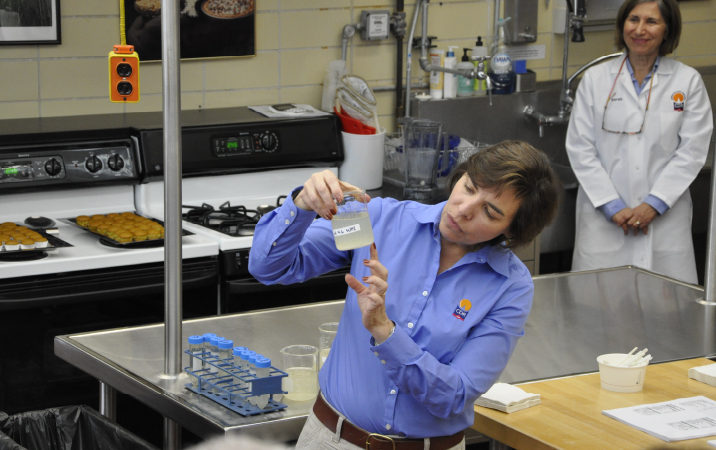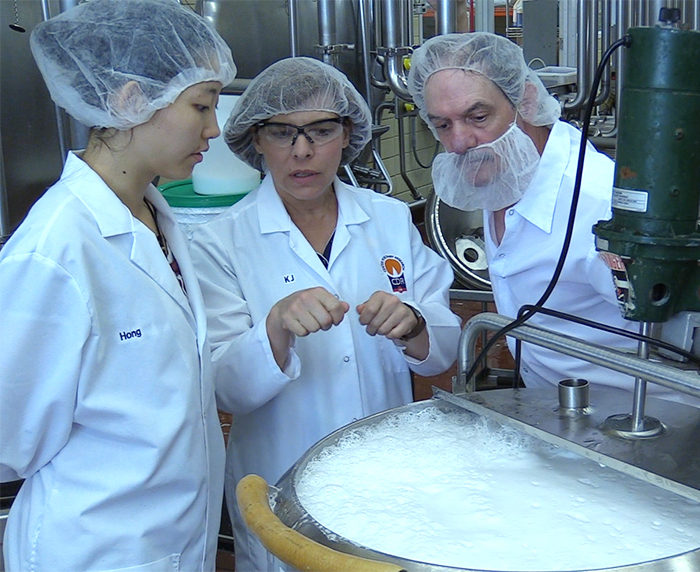Formulating Dairy Protein Beverages
This article first appeared in the Winter 2019 issue of the Dairy Pipeline.
Dairy protein beverages are an exciting area for the dairy industry. Innovative new products are hitting the shelves and consumers are beginning to appreciate the nutritional value of beverages made with dairy proteins. Additionally, there is room in the market for more dairy beverage products.
However, when developing these beverages, it is important to have a good understanding of the functionality of different dairy protein ingredients. For more than 20 years, the Center for Dairy Research’s Beverage Applications Program has been a leader in helping companies and entrepreneurs develop dairy protein beverages. Staff are well versed in using milk and whey protein ingredients, as well as non-protein dairy ingredients such as permeate.
High Acid or Low Acid?
In the beverage world, there are two categories—low acid and high acid. A low acid beverage is typically anything above pH 4.6. A high acid beverage is anything below pH 4.6. According to KJ Burrington, CDR’s Dairy Ingredients, Beverages & Cultured Products Coordinator, when a company or entrepreneur works with CDR on a beverage, her first question is what’s the pH?
Selecting a pH is especially important when developing a beverage using dairy proteins. Generally speaking, whey protein ingredients work best in high acid beverages and milk protein ingredients have better functionality in low acid beverages. Depending on the pH, stabilizers might be needed to add stability to the dairy protein. For instance, a whey protein isolate can be used to develop a clear high acid beverage. However, if the beverage has a “mid-range” pH (between 3.5 and 4.5), a stabilizer like pectin might be needed because the whey proteins are closer to their isoelectric point and a stabilizer like pectin will help prevent aggregation of the whey proteins during the heat process. The level of acidity plays a big role in the development of a beverage.
Processing Conditions
In addition to dictating what dairy protein ingredient to use, the pH of a beverage will also dictate the processing conditions. For instance, low acid beverages that are shelf stable essentially have two processing options— retort and ultra high temperature (UHT). Retort is a very high temperature treatment (250-300°F) for a long amount of time (20-40 minutes). Retort products are shelf stable and are typically in bottles or cans. UHT processing is a high temperature (above 275°F) treatment but for a very short time (2 to 5 seconds). UHT is also shelf stable if it is aseptically packaged in cartons or bottles. There is also one “in between” processing option for low acid beverages: extended shelf life (ESL). These products undergo the UHT process but are not packaged aseptically. ESL is currently used for some low acid filtered milk products and coffee drinks and require refrigeration.
For shelf stable high acid beverages, the typical processing option is hot fill. During the hot fill process, the beverage is heated >180F for up to 2 minutes, filled hot into the bottle and then cooled. Of course, high acid beverages pose less pathogen risk than low acid beverages. Even if a pathogen is present in a high acid beverage it will die off very quickly because of the low pH. Another processing option for high acid beverages is basic pasteurization. Some smoothie products are pasteurized. However, these products require refrigeration.

Which Ingredient to Use?
Once the pH and the processing conditions are determined, then it’s time to select a dairy protein ingredient.
“For high acid beverages, we almost always recommend whey proteins because they have better solubility and heat stability at that pH [below 4.6],” Burrington said. “Most low acid beverages are in the pH range of 6-7, so we will always recommend milk proteins over whey because milk proteins are going to have the best solubility and heat stability in that pH range."
Examples of whey proteins include whey protein concentrates (WPC), whey protein isolates (WPI), and milk-derived whey. Milk proteins include milk protein concentrates (MPC), milk protein isolates (MPI), and micellar casein.
Isolates and concentrates have their pros and cons. A concentrate is going to cost less but it will also have more lactose and minerals, which will contribute to the overall sugar content. Concentrates will also have some fat, which is going to produce a more cloudy, milky product. In addition, the mineral content of concentrates can also create some instability depending on the pH. So, even though isolates cost more, some manufacturers opt for isolates because, among other factors, they can produce a beverage with a lower sugar content and the best clarity, which is important for protein waters.
One of the newer milk protein ingredients is micellar casein. This ingredient is different than an isolate or concentrate because it is processed by microfiltration (MF) while concentrates and isolates are most commonly made by ultrafiltration (UF). MF separates the casein from the whey protein. So micellar casein will have the same protein level as a concentrate or an isolate, but the protein composition has changed to be predominantly casein. There are about four companies making micellar casein in the U.S. and they will typically produce it in the range of 90-95 percent casein (compared to MPC, which is about 80 percent casein). Micellar casein could have a couple of advantages. It should be more heat stable because it has less whey proteins. Micellar caseins also tend to develop less sulfur aroma during UHT or retort processing, due to the lower whey protein content.
There is also a new whey ingredient called milk derived whey. “This ingredient is different than cheese derived whey because the milk derived whey has never gone through a cheesemaking process,” Burrington said. “The flavor of milk derived whey is going to be very clean—it doesn’t have any of the flavors that the cultures have created or from the extra heat processing that has happened as the whey is further processed. It has a clean, milky flavor that a lot of people like.”
In addition, milk derived whey contains no fat (in the MF process, the fat is separated from the whey protein stream). Since it has no fat, milk derived whey is very clear like a WPI, which makes it a good option for clear beverages like protein waters.
Hydration is Essential for Dry Dairy Proteins
Some of the solubility and heat stability issues that are seen with dairy protein beverages can be avoided by properly hydrating the dairy proteins before they are added to the beverage formulation.
Milk proteins are especially important to hydrate properly. Burrington says milk proteins need to be hydrated for about an hour at 50°C (120°F minimum). “We always recommend warmer temperatures for milk proteins because they are very slow to hydrate and warmer temperatures help optimize their hydration conditions,” Burrington said. On whey protein side, it takes less time—about 20 to 30 minutes at no higher than 130°F. It is important not to exceed 130°F because you want to avoid denaturing the whey proteins.
Hydrating dairy proteins is important, especially as drinks are being produced with higher levels of protein. Poorly hydrated MPC or MPI ingredients will lead to defects like a grainy texture or protein settling in the finished beverage. Properly hydrating the proteins will help avoid these issues and improve the quality of the beverage.
“Hydrating dairy proteins is important, especially as drinks are being produced with higher levels of protein. Poorly hydrated MPC or MPI ingredients will lead to defects like a grainy texture or protein settling in the finished beverage.”
Processing Aids
There are a couple of special considerations when developing beverages, especially low acid beverages, in order to help the dairy proteins go through the heating process without getting damaged. For instance, often in low acid beverages, a stabilizer will need to be added (like carrageenan or gellan gum). These will help protect the protein and also prevent it from interacting with itself. The other consideration is that in a high heat process (like UHT), the Maillard reaction occurs. This reaction will drop the pH of the beverage, which can create protein instability. One way to help stabilize the pH is by adding buffer salts (usually mono-, di-, or polyphosphates). These buffers help hold the pH up and some will also chelate calcium (sometimes calcium will also cause protein instability). The buffer salts are not perceived as clean label by some consumers but they really help make the beverage more stable.
Custom Dairy Ingredients
A couple of U.S. companies produce an MPC with a reduced calcium content as a way to avoid the use of buffers and to achieve a clean label. These special MPCs with reduced calcium are more heat stable and are a nice option for low acid dairy protein beverages.
One consideration when producing a beverage with whey proteins is to use a pre-acidified whey protein isolate. One issue that manufacturers face when making beverages with whey protein isolates is that the pH of the beverage formulation needs to be decreased sometimes as low as pH 3.0 with the addition of an acid like phosphoric, citric or malic acid. Depending on the level of protein in the beverage, the amount of acid added could be very high. Several companies in the U.S. have developed a pre-acidified whey protein isolate that makes it much easier for the processor and also makes a whey protein ingredient that will be less astringent in the finished beverage.
As mentioned at the beginning of this article, dairy protein beverages are a still emerging and developing area of the dairy industry. Most dairy protein beverages are focused on muscle health, whether it be focused on sports (muscle recovery), weight management (lean muscle) or healthy aging (maintaining muscle). Burrington said that there is room in the market for more products, “The one area that I think we’re really short on is the healthy aging category. There are very few products in the market. That’s one area that in which I’ve been really encouraging companies to develop products.”
CDR is also working to increase its ability to support companies and entrepreneurs develop new beverages. Babcock Hall, which houses CDR , is undergoing a building project. As part of that project and with support from the Wisconsin Economic Development Corporation, CDR will be able to offer small-scale aseptic processing equipment. More information will be made available when the equipment is ready for use.
For more information or for technical support regarding dairy protein beverages, contact CDR's Beverages staff.
Additional Resource
U.S. Dairy Ingredients in Ready-to-Drink Beverages (U.S. Dairy Export Council)


